The news is that Daimler, Audi, and BMW have paid some US $3 billion for Here, Nokia’s road-mapping service. The question is why they did it.
Because of self-driving cars, you might respond. Well, yes, superaccurate road maps are increasingly useful to cars that think, serving as a kind of sixth sense (after radar, lidar, sonar, odometry, and inertial guidance). A first-rate map might lead you to your exit even when the exit sign is covered in snow.
But why buy a mapping service of your own when you can use Google, Tom Tom or, for that matter, Here? Why own when you can rent?
Evidently the three German car makers figured that mapping is so much a part of their core business that they must set aside their rivalries to get their collective hands on it. Maybe they worry that Google might charge too much for access to its maps, and that the same would be true with Baidu or even Apple (new to mapping, but a behemoth just the same).
Or maybe they acted out of fear. The three companies all use Here in their cars today—it’s found in 80 percent of cars that have dashboard navigation services—and if a rival transportation company were to snap up the service, it could be uncomfortable for them. Uber, the ride-hailing app, was reportedly interested in acquiring Here, as were Baidu and others, but they withdrew their bids some weeks ago.
The German car consortium was thus able to drive a harder bargain than Nokia’s reported initial goal of $4 billion. Therefore, you could say that today’s price is a great deal, but only if you buy into the logic of a bidding frenzy. In any case, there is now the little matter of paying for it all.
For now, the German companies say they won’t hog Here’s maps but “will expand its product offering and continue to make it available to all customers across industries.” That will have to do until self-driving technology advances enough to make this $3 billion acquisition pay for itself.
Just because the brains of the car are increasingly valuable doesn’t mean that car makers have to own those brains. What to own and what to rent remains unclear.
At one extreme—now totally out of fashion—you own everything. The quintessential example is the fabled factory complex Henry Ford built on Michigan’s River Rouge in the 1920s, which took in raw materials and churned out finished automobiles.
The other extreme is to outsource nearly everything, as Boeing’s Dreamliner project did. In this case, at least, sacrificing central control helped to delay the airliner’s debut and contributed to some rather embarrassing fires due failures in lithium-ion batteries supplied by Japan’s GS Yuasa.
Car makers no longer make their own steel and glass. They don’t make gasoline or electricity. Should they really be making their own maps?
Philip E. Ross is a senior editor at IEEE Spectrum. His interests include transportation, energy storage, AI, and the economic aspects of technology. He has a master's degree in international affairs from Columbia University and another, in journalism, from the University of Michigan.



